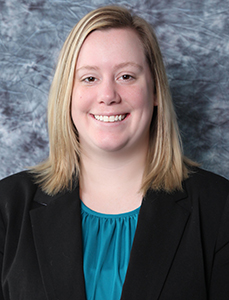During this difficult and unpredictable time, everyone is faced with new challenges. These challenges may be exacerbated for individuals with Autism Spectrum Disorder (ASD). School and daycare closures and a decrease in employment, among other changes, have caused a significant disruption to daily life and routines. Predictability, structure, and routine are essential aspects of everyone’s life. This is especially true for those diagnosed with ASD. Our world continues to adapt and change to the COVID-19 pandemic, and it is important that direct care staff and clinicians continue to keep the best interest of their clients at the forefront of their programming.

Jennifer Croner, MSEd, BCBA, LBS-PA

Samantha Smith, MSEd, BCBA, LBS-PA
The Centers for Disease Control and Prevention (CDC) have continually updated recommendations in order to slow the spread of the virus. One of the latest recommendations indicates that everyone over the age of two should be wearing a cloth mask whenever out in a public area with the exception of those who are unable to take the mask off independently, have difficulty breathing, or are unconscious (CDC, 2020). The greatest danger of this virus is in pre-symptomatic and asymptomatic individuals thus the need for everyone to wear a mask. This may pose an issue for individuals with ASD. Marco, Hinkley, Hill, and Nagarajan (2011) report that 96% of individuals with ASD have a hyper- or hypo-sensitivity in multiple sensory domains. Many clinicians and researchers have worked on toleration procedures for a variety of anxiety-inducing behaviors including general medical examinations, dental procedures, and approaching aversive stimuli (e.g., Cavalari, DuBard, Luiselli, & Birtwell, 2013; Hagopian and Jennett, 2008). Hagopian and Jennett (2008) reported that these procedures generally include graduated exposure, reinforcement, prompting, modeling, shaping, response prevention, and distracting stimuli. Unfortunately, there is limited, if any, research on toleration specifically in regard to cloth face masks. These research studies focus on teaching the individual to tolerate the medical procedure or aversive event. There are currently no recommendations on how to increase toleration of a direct care staff or clinician wearing a medical device or mask themselves; some clients may find this aversive as well. Several aspects of mask toleration are going to be a necessity as the world continues to transition to a new state of normal.
When following these recommendations clients may engage in challenging behavior when they are asked to wear a mask. This also may occur if a direct care staff wears a mask when delivering behavioral therapy. As direct care staff are considered essential workers, they are required to wear a mask while they are providing services. When creating programs to increase an individual’s tolerance of wearing a mask, many of the procedures may transfer to increasing toleration of a direct care staff wearing a mask. These procedures are likely to occur simultaneously to ensure the health of everyone during service delivery. Procedures that may assist in increasing toleration are providing the individual the rationale for wearing a mask; model how to put the mask on and take it off on yourself, caregivers, or preferred items (e.g., stuffed animals) noting that the mask will keep others and themselves safe; when first targeting mask toleration, incorporate graduated exposure into preferred activities to increase the likelihood of compliance; and provide corrections when the individual removes the mask during required times.
An excellent opportunity to include choice and preference during these procedures is to include the individual in choosing the mask design. You can also have them decorate the mask themselves, but you should be careful that modifications do not decrease its effectiveness. Another important aspect to include is reinforcement for wearing the mask but ensure that the reinforcement is functional! Based on recent observations many individuals are attempting to escape the demand of putting the mask on or avoid the sensory stimulation. Therefore, removing the mask for periods of time following an appropriate request after they hit the targeted duration would increase the future likelihood of them wearing the mask for a lengthy amount of time (i.e., shaping). When removing the mask make sure to move six feet from the individual to ensure social distancing is followed when they are not protected by the mask. It may also be beneficial to provide other preferred items following the target duration or items that you may save for particular procedures that are of very high value (e.g., if they have a preferred snack or toy only provide access after they keep the mask on for the target amount of time and slowly increase the amount of time they are wearing it as they are successful).
The nature of our work requires that we are close to our individuals when providing instruction with physical prompting, blocking challenging behavior such as self-injurious behavior, engaging in play behaviors, or when providing physical attention as a reinforcer. Therefore, the toleration of masks on both the client and the clinician is imperative. Many of the individuals we work with also require specific prompts to engage in a correct response that involve using our mouths such as when teaching an individual to move their mouth in a particular manner to emit speech or modeling an open mouth when brushing their teeth. It is important to determine the ethical considerations in removing some of these programs for a short period of time or finding alternative ways to prompt such as video modeling.
Overall, the safety of our clients, direct care staff, and clinicians is of the utmost importance during this time and vital to ensuring the ongoing service provision to those in need. With the hope that the need for this level of protection is short-lived, clinicians must recognize that swift and immediate action is imperative. Other helpful programs to include as part of your client’s program during this time include thorough hand washing, wearing and safely removing latex gloves, using hand sanitizer, using lotion, covering coughs and sneezes using their arm, disinfecting surfaces, and understanding how to engage in social distancing. These procedures may assist in maintaining a healthy, safe lifestyle until the dangers of this virus subside.
Samantha Smith, MSEd, BCBA, LBS-PA, is Clinical Supervisor and Jennifer Croner, MSEd, BCBA, LBS-PA is Director of Clinical Services and Professional Development at Exceptional Learning, LLC. If you would like more information about Exceptional Learning, LLC, please contact our office via phone at (610) 287-4000 or visit our website at www.exceptional-learning.com.
References
Cavalari, R. N., DuBard, M., Luiselli, J. K., & Birtwell, K. (2013). Teaching an adolescent with autism and intellectual disability to tolerate routine medical examination: Effects of a behavioral compliance training package. Clinical Practice in Pediatric Psychology, 1(2), 121.
Centers for Disease Control and Prevention. (2020, April 13). Use of cloth face coverings to help slow the spread of COVID-19. Retrieved May 11, 2020 from www.cdc.gov/coronavirus/2019-ncov/prevent-getting-sick/diy-cloth-face-coverings.html
Hagopian, L. P., & Jennett, H. K. (2008). Behavioral assessment and treatment of anxiety in individuals with intellectual disabilities and autism. Journal of Developmental and Physical Disabilities, 20(5), 467-483.
Marco, E. J., Hinkley, L. B., Hill, S. S., & Nagarajan, S. S. (2011). Sensory processing in autism: a review of neurophysiologic findings. Pediatric research, 69(5 Pt 2), 48R–54R. https://doi.org/10.1203/PDR.0b013e3182130c54





